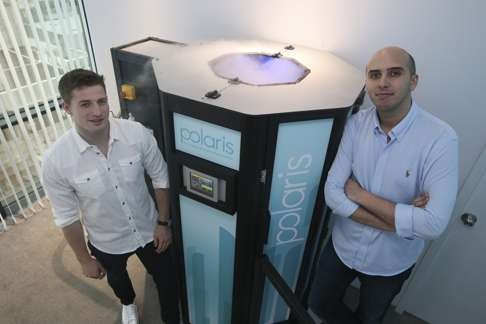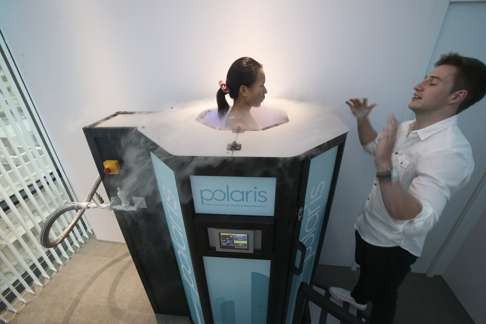
Nipple stickers at the ready, we try Hong Kong’s first cryosauna – at minus 130 Celsius
Polaris Wellness offers cryotherapy sessions that it claims reduce post-exercise soreness and speed up recovery. Health editor Jeanette Wang puts its super chilled chamber to the test
Wearing only gloves, socks, diving boots, disposable underwear and nipple stickers, to say I was underdressed for the cold would be an understatement. Especially since it was not 13 degrees Celsius or even minus 13 degrees, but minus 130 degrees – colder than anywhere else on Earth.
In a room in Causeway Bay, as the blazing sun cooks the streets below, my teeth chatter and my body shivers furiously. Three minutes seem to crawl by in the cryosauna. My mind is as foggy as the room, which is becoming clouded by nitrogen fumes from the cryosauna chamber.
Having destroyed my legs in a challenging trail running race the day before, I am curious to see if whole body cryotherapy lives up to its promise of reducing post-exercise soreness and speeding up recovery.

Many other international sports stars, such as Floyd Mayweather Jnr, Michael Phelps and LeBron James have also used the technology to keep in peak shape. In Hong Kong, Polaris has had runners, swimmers, rugby players, crossfitters and mixed martial artists try out its sleek, white, 2,000 sq ft facility on the 10th floor of Lee Theatre Plaza.
“Cryotherapy can improve performance, decrease fatigue, reduce post-workout pain, accelerate recovery and control inflammation,” says Polaris founder and CEO Nawfel Oussedik. And the applications go beyond sports and fitness.
For those concerned with aesthetics, cryotherapy is said to firm and tighten skin, improve skin smoothness, reduce cellulite, help manage weight and promote biological rejuvenation. For general health and wellness, Oussedik says cryotherapy can increase energy and motivation, regulate sleeping patterns, reduce chronic pain, boost the immune system, help with jet lag, and treat inflammatory and autoimmune diseases.

But not everyone’s convinced. Dr Lobo Louie Hung-tak, an associate professor in Baptist University’s department of physical education, says the claims made about cryotherapy on the Polaris Wellness website are “too exaggerated”.
“I don’t think there’s any evidence-based research showing that cryotherapy can promote health from the holistic approach,” says Louie. “There’s only evidence for it as treatment for acute sports injuries and promoting faster recovery in athletes.”
Cryotherapy can improve performance, decrease fatigue, reduce post-workout pain, accelerate recovery and control inflammation
Cryotherapy may be trending but it’s actually a few decades old, Louie says. Before cryosaunas, cryotherapy – which literally means cold therapy – existed in the form of ice baths and ice packs. (In the medical world cryotherapy usually refers to a surgical procedure called cryoablation where extreme cold is used to destroy abnormal or diseased tissue – we won’t touch on this here.)
“The theory is that cold therapy can reduce the blood flow to the local muscles, and in principle it can reduce the inflammation within the muscle fibres, which means you can recover faster,” says Louie. “Some literature supports this, but some other studies found no significant effect. But at least it’s very good for athletes mentally, because if they think the cold helps them recover faster, psychologically they can perform better.”
Research on whole-body cryotherapy and cryosaunas is scarce. One study, by the University of Ulster published in 2014 in the Open Access Journal of Sports Medicine, reviewed the efficacy and effectiveness of the therapy using empirical evidence from 10 relevant controlled trials.
The researchers found weak evidence that the treatment enhances antioxidant capacity and parasympathetic reactivation, and alters inflammatory pathways relevant to sports recovery. A series of small randomised studies found it offers improvements in subjective recovery and muscle soreness following metabolic or mechanical overload, but little benefit towards functional recovery.
“Until further research is available, athletes should remain aware that cheaper modes of cryotherapy, such as local ice-pack application or immersion in cold water, offer comparable physiological and clinical effects to whole body cryotherapy,” the researchers concluded.
Dr Chris Bleakley, one of the scientists, says: “It’s important to take home the message that just because something feels cool on the skin, it doesn’t necessarily mean that all other potential therapeutic effects of cooling are happening.”

“We offer ‘buy one, get one free’ for first-timers – because you need at least two visits to experience an effect,” Oussedik says. Nine out of 10 times, he says, people end up buying a membership for six or 12 months, which costs from HK$5,544 to HK$15,903 per month.
There have also been two inquiries about having the cryosauna installed at home, Oussedik says. It costs about US$100,000 for non-commercial use. In a few months’ time, Polaris will have a second outlet in Central.
Whole-body cryotherapy is not for everyone; there’s a list of contraindications to the treatment: pregnancy, severe hypertension (blood pressure higher than 180/100), acute or recent myocardial infarction, unstable angina pectoris, arrhythmia, symptomatic cardiovascular disease, cardiac pacemaker, peripheral arterial occlusive disease, venous thrombosis, acute or recent cerebrovascular accident, uncontrolled seizures, Raynaud’s Syndrome, fever, tumour disease, symptomatic lung disorders, bleeding disorders, severe anaemia, infection, claustrophobia, cold allergy, acute kidney and urinary tract diseases.
Users of cryotherapy should also be aware of the low oxygen levels in the chambers during treatments, which could be under 5 per cent. Normal air contains about 21 per cent oxygen. Last year, a spa worker was found dead in the liquid-nitrogen-cooled chamber at a Las Vegas cryotherapy centre and investigations showed she had died accidentally from suffocation.
Just because something feels cool on the skin, it doesn’t necessarily mean that all other potential therapeutic effects of cooling are happening
Elsa Jean de Dieu, a top trail runner in Hong Kong, tried a treatment at Polaris after a 42km race and says she could feel “a real change” in her body after just one session. “A few hours later I still had a good feeling and the day after I had no pain in my legs,” she says.
Top Hong Kong triathlete Kate Rutherford has had three sessions so far, each immediately after a race. “After each session I come away feeling energised and relaxed, as if a weight has been taken off me ... I think it helps reduce the inflammation from racing and I’ve been able to get back to training quickly. But it doesn’t eliminate all the muscle pain,” she says.
Rutherford says she plans to continue cryotherapy but also her own rehabilitation routine, which includes foam rolling, stretching and deep-heat self massage.
I left the chamber feeling revitalised, re-energised and incredibly relaxed (to the point of wanting to nap), and the soreness in my thighs and calves seemed to have been numbed. But a couple of hours later my legs felt as sore as before the treatment and fatigue set in again. Perhaps, like many treatments, you need regular cryotherapy sessions for a real effect.

